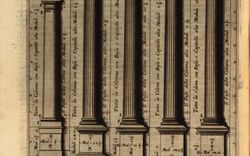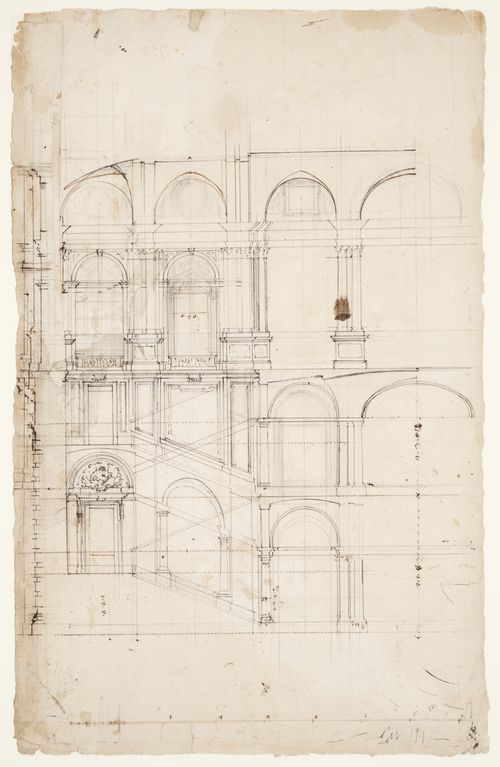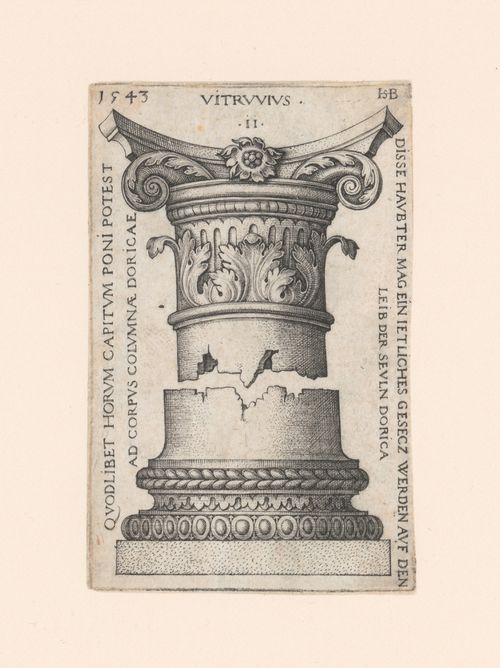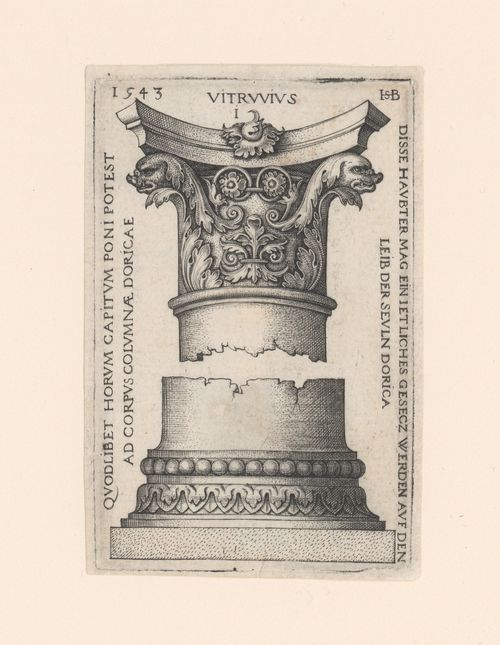articles
Mettre en doute la théorie
Boîte à outils pour aujourd'hui 2021, programme de doctorat, recherche, en suspicion de, théorie, linguistique, sémiotique, années 1970, Legalities for Living, doute, design généré par l'utilisateur, corps idéaux, ornement du début de l'ère moderne
12 juin 2023
Mettre en doute la théorie
Dijana O. Apostolski, Jana Berankova, Amir Taheri, Vitório Leite
Actions:
DR1978:0008:012
Description:
- This partial section through Castello di Rivoli, Turin, shows design details for wall ornament which are suggested by sketches in some of the archways. It has not been determined whether the exterior wall section at the upper left of this drawing was executed on a separate sheet or torn off and repaired. Comparison with drawing DR1978:0008:011, which shows the same section through the castello, indicates that this exterior wall section was probably part of the building.
architecture
between 1714 and 1721
Partial section through Castello di Rivoli, Turin, showing stairways
Actions:
DR1978:0008:012
Description:
- This partial section through Castello di Rivoli, Turin, shows design details for wall ornament which are suggested by sketches in some of the archways. It has not been determined whether the exterior wall section at the upper left of this drawing was executed on a separate sheet or torn off and repaired. Comparison with drawing DR1978:0008:011, which shows the same section through the castello, indicates that this exterior wall section was probably part of the building.
architecture
documents textuels
AP178.S1.2002.PR05.SS1.065.2
Description:
Original file title: Hotel Palace de Vidago e spa geral This file includes a study for the interior ornaments.
2007-2008
Project documentation and correspondence, Parque de Vidago, Complexo Termal e Hotel Palace, Vidago (folder 2 of 3)
Actions:
AP178.S1.2002.PR05.SS1.065.2
Description:
Original file title: Hotel Palace de Vidago e spa geral This file includes a study for the interior ornaments.
documents textuels
2007-2008
photographies
Plate
PH1989:0262.03:018
Description:
Large plate ewer for a race-cup in repoussé work, representing Hercules combating the horses of Diomedes, and ornaments and emblems symbolical of the labours of Hercules.
ornement
1851
Plate
Actions:
PH1989:0262.03:018
Description:
Large plate ewer for a race-cup in repoussé work, representing Hercules combating the horses of Diomedes, and ornaments and emblems symbolical of the labours of Hercules.
photographies
1851
ornement
DR1987:0344
Description:
- This engraving depicts a design for an order of architecture showing the capital and the base. Although the inscriptions refer to "This engraving depicts a dORICA[E]", this looks more like a variation on the composite order. - This print is one of a set of four prints of capitals and bases which were engraved by Hans Sebald Beham. Patricia Condon suggests that these prints were made for a general audience rather than for architects ('Ornament and Architecture', 29). Three of the prints in the CCA collection are from the collection of the Ducs d'Arenburg, while the provenance of the fourth print, DR1987:0342, is unknown.
architecture
1545
Design for the capital and base of a column
Actions:
DR1987:0344
Description:
- This engraving depicts a design for an order of architecture showing the capital and the base. Although the inscriptions refer to "This engraving depicts a dORICA[E]", this looks more like a variation on the composite order. - This print is one of a set of four prints of capitals and bases which were engraved by Hans Sebald Beham. Patricia Condon suggests that these prints were made for a general audience rather than for architects ('Ornament and Architecture', 29). Three of the prints in the CCA collection are from the collection of the Ducs d'Arenburg, while the provenance of the fourth print, DR1987:0342, is unknown.
architecture
DR1987:0345
Description:
- This engraving depicts a design for an order of architecture showing the capital and the base. Although the inscriptions refer to "This engraving depicts a dORICA[E]", this is not one of the traditional orders of architecture. - This print is one of a set of four prints of capitals and bases which were engraved by Hans Sebald Beham. Patricia Condon suggests that these prints were made for a general audience rather than for architects ('Ornament and Architecture', 29). Three of the prints in the CCA collection are from the collection of the Ducs d'Arenburg, while the provenance of the fourth print, DR1987:0342, is unknown.
architecture
1545
Design for the capital and base of a column
Actions:
DR1987:0345
Description:
- This engraving depicts a design for an order of architecture showing the capital and the base. Although the inscriptions refer to "This engraving depicts a dORICA[E]", this is not one of the traditional orders of architecture. - This print is one of a set of four prints of capitals and bases which were engraved by Hans Sebald Beham. Patricia Condon suggests that these prints were made for a general audience rather than for architects ('Ornament and Architecture', 29). Three of the prints in the CCA collection are from the collection of the Ducs d'Arenburg, while the provenance of the fourth print, DR1987:0342, is unknown.
architecture
DR1987:0343
Description:
- This engraving depicts a design for an order of architecture showing the capital and the base. Although the inscriptions refer to "This engraving depicts a dORICA[E]", this column looks more like a variation on the composite order. - This print is one of a set of four prints of capitals and bases which were engraved by Hans Sebald Beham. Patricia Condon suggests that these prints were made for a general audience rather than for architects ('Ornament and Architecture', 29). Three of the prints in the CCA collection are from the collection of the Ducs d'Arenburg, while the provenance of the fourth print, DR1987:0342, is unknown.
architecture
1543
Design for the capital and base of a column
Actions:
DR1987:0343
Description:
- This engraving depicts a design for an order of architecture showing the capital and the base. Although the inscriptions refer to "This engraving depicts a dORICA[E]", this column looks more like a variation on the composite order. - This print is one of a set of four prints of capitals and bases which were engraved by Hans Sebald Beham. Patricia Condon suggests that these prints were made for a general audience rather than for architects ('Ornament and Architecture', 29). Three of the prints in the CCA collection are from the collection of the Ducs d'Arenburg, while the provenance of the fourth print, DR1987:0342, is unknown.
architecture
Sous-série
Education
CI001.S2.D1
Description:
Like his father Hubert, Charles Rohault de Fleury also studied at the École polytechnique with Jean-Nicolas-Louis Durand (1820-1821), and at the École des Beaux-Arts (1823-1825), Charles studied under his father and Louis Hippolyte Lebas. The CCA collection contains his printed exercise book from the École polytechnique and an album of drawings of the orders executed at both schools. The printed exercise book (DR1974:0002:001:001-105), primarily dated to 1821, provides an overview of the first year curriculum at the École polytechnique reflecting the emphasis placed on the course in descriptive geometry. The exercises proceed from the simple to the complex; from the analysis of simple shapes to the interpretation of basic architectural elements. Many of the problems have been solved by Charles, and carry the approval seal of his professor. A large engraving included in the album provides a succinct table recording the career paths of graduating students in the various Écoles d'application, a description of the core curriculum, and a historical and chronological outline of the École polytechnique from its inception to 1828. Charles' studies of the architectural orders (DR1974:0002:019:001-033), many of which are copied directly from Charles Normand's 'Nouveau parallele des ordres d'architecture...,' demonstrate the continued application of Durand's methodology applied to typical Beaux-Arts studies. The orders executed at the École polytechnique are pared down to their essential form and porticos are abstracted and grouped according to their tetrastyle, hexastyle, or octastyle configurations, whereas the orders completed at the École des beaux-arts are simplified, but still reflect the traditional mimetic interpretation of classical antiquity, with its fidelity to mouldings and details. The conspicous abscence of the composite order and the addition of the 'Dorique Romain and Moderne', attest to the continued influence of Durand's ''Precis'. The information regarding George's architectural career is limited to twelve drawings for architectural ornament and sculpture (1858-1859) submitted to a newly introduced, and obligatory, 'dessin' Concours d'emulation at the École des beaux-arts (1). (1) R. Chaffe, "The teaching of architecture at the École des Beaux-Arts" in Arthur Drexler ed., 'The Architecture of the École des Beaux-Arts' (New York: MOMA, 1975), p.84 and fn. 120.)
[1776?]-1868
Education
CI001.S2.D1
Description:
Like his father Hubert, Charles Rohault de Fleury also studied at the École polytechnique with Jean-Nicolas-Louis Durand (1820-1821), and at the École des Beaux-Arts (1823-1825), Charles studied under his father and Louis Hippolyte Lebas. The CCA collection contains his printed exercise book from the École polytechnique and an album of drawings of the orders executed at both schools. The printed exercise book (DR1974:0002:001:001-105), primarily dated to 1821, provides an overview of the first year curriculum at the École polytechnique reflecting the emphasis placed on the course in descriptive geometry. The exercises proceed from the simple to the complex; from the analysis of simple shapes to the interpretation of basic architectural elements. Many of the problems have been solved by Charles, and carry the approval seal of his professor. A large engraving included in the album provides a succinct table recording the career paths of graduating students in the various Écoles d'application, a description of the core curriculum, and a historical and chronological outline of the École polytechnique from its inception to 1828. Charles' studies of the architectural orders (DR1974:0002:019:001-033), many of which are copied directly from Charles Normand's 'Nouveau parallele des ordres d'architecture...,' demonstrate the continued application of Durand's methodology applied to typical Beaux-Arts studies. The orders executed at the École polytechnique are pared down to their essential form and porticos are abstracted and grouped according to their tetrastyle, hexastyle, or octastyle configurations, whereas the orders completed at the École des beaux-arts are simplified, but still reflect the traditional mimetic interpretation of classical antiquity, with its fidelity to mouldings and details. The conspicous abscence of the composite order and the addition of the 'Dorique Romain and Moderne', attest to the continued influence of Durand's ''Precis'. The information regarding George's architectural career is limited to twelve drawings for architectural ornament and sculpture (1858-1859) submitted to a newly introduced, and obligatory, 'dessin' Concours d'emulation at the École des beaux-arts (1). (1) R. Chaffe, "The teaching of architecture at the École des Beaux-Arts" in Arthur Drexler ed., 'The Architecture of the École des Beaux-Arts' (New York: MOMA, 1975), p.84 and fn. 120.)
File 1
[1776?]-1868
dessins
Quantité:
31 drawing(s)
ARCH197120
Description:
Plans, elevations, decorative and structural details for chairs, fireplace ornaments, candlesticks, tables, consoles, benches and vases. Includes plans and elevations for the S/E/2 Chair and the S/D/2 Chair.
Plans, elevations, decorative and structural details for chairs
Actions:
ARCH197120
Description:
Plans, elevations, decorative and structural details for chairs, fireplace ornaments, candlesticks, tables, consoles, benches and vases. Includes plans and elevations for the S/E/2 Chair and the S/D/2 Chair.
dessins
Quantité:
31 drawing(s)
DR1987:0342
Description:
- This engraving depicts a design for an order of architecture showing the capital and the base. Although the inscriptions refer to "DORICA[E]", this is not one of the traditional orders of architecture: the acanthus leaves on the capital suggest a Corinthian model while other details, such as the dolphin heads, suggest a more personal interpretation. - This print is one of a set of four prints of capitals and bases which were engraved by Hans Sebald Beham. Patricia Condon suggests that these prints were made for a general audience rather than for architects ('Ornament and Architecture', 29). Three of the prints in the CCA collection are from the collection of the Ducs d'Arenburg, while the provenance of this print is unknown.
architecture
1543
Design for the capital and base of a column
Actions:
DR1987:0342
Description:
- This engraving depicts a design for an order of architecture showing the capital and the base. Although the inscriptions refer to "DORICA[E]", this is not one of the traditional orders of architecture: the acanthus leaves on the capital suggest a Corinthian model while other details, such as the dolphin heads, suggest a more personal interpretation. - This print is one of a set of four prints of capitals and bases which were engraved by Hans Sebald Beham. Patricia Condon suggests that these prints were made for a general audience rather than for architects ('Ornament and Architecture', 29). Three of the prints in the CCA collection are from the collection of the Ducs d'Arenburg, while the provenance of this print is unknown.
architecture





